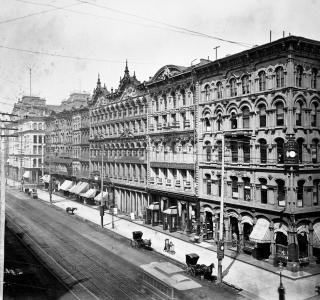“The worst of
times, whether fire, flood, famine or war, can bring out the best in people
anywhere.” (Jo Ann Rayfield)

Home of William Bross in ruins courtesy interactive.wttw.com.
Before the ground had cooled, Chicagoans started to
rebuild. Before the bricks had stopped
smoking, city residents collected them to possibly reuse. A Chicago Tribune editorial announced:
"In the midst of a calamity without parallel in the world's history, looking upon the ashes of thirty years' accumulations, the people of this once beautiful city have resolved that CHICAGO WILL RISE AGAIN."
President Grant offered $1000 dollars to start the
rebuilding. Potter Palmer, who had lost
32 buildings in the Great Fire, raised $3 million towards the project. In the years 1872 to 1879, 10,000
construction permits were applied for in the city of Chicago . Thankfully, the city’s railroad station and
yard remained intact as well as the lumber market which aided tremendously in
the rebuilding effort.
A new Chicago law
stated that all new buildings would not be made of wood, but rather brick,
stone, marble or limestone. And a new
material was introduced named terra cotta.
The Palmer House owner had buried the blueprints to his hotel under
terra cotta. While the hotel burned, the
blueprints remained safe. Terra cotta
was declared a fireproof material.
With its close quarters, land was at a premium in downtown Chicago . In 1880, a quarter acre was valued at
$130,000. Ten years later, the same size
lot was worth $900,000. City planners
realized the only way to expand was upwards.
That is how the skyscraper was born.
Chicago boasted the first
one, Jenney’s Home Insurance
Building
A new architectural movement, the Chicago School of
Architecture, was born. Its members
included William Jenney, Louis Sullivan, John Root and Daniel Burnham. Their new vision featured tall buildings with
a skeleton construction; their frames were held up not by exterior walls, but
by an interior skeleton. The edifices
featured large exterior windows and limited exterior ornamentation. Jenney's new skyscraper was ten stories high. Sullivan’s idea that “form follows function”
was radical for the time period. Root’s
rail-grillage technique, of reinforcing concrete walls with steel rails, was
also new. Burnham came to the drawing
table with much experience, having designed the Flatiron
Building New
York City as well as the Chicago World’s Fair.
Construction was rapid and labour costs were low. One by one, the buildings sprouted up on Chicago ’s
downtown streets. Within 25 years, the
city was completely rebuilt. Chicago
turned its greatest weakness into its strength.
Today it is considered an architectural marvel.

A rebuilt block at State & Madison Streets courtesy www.greatchicagofire.org.
No comments:
Post a Comment